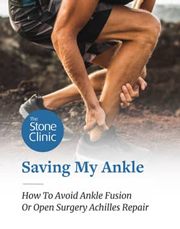Unstable Ankles
Hear From Our Patients
Ankle Ligament Instability Corrected for College Tennis PlayerA quick ankle twist. It’s a move that leads frequently to an ankle sprain and, unfortunately, it happens all the time. You can sprain your ankle by just stepping off a curb the wrong way. If the force is great enough, it will stretch your ligaments beyond their normal range to a point where they tear. According to the American Academy of Orthopaedic Surgeons, approximately 25,000 people sprain their ankle each day.

Ankle sprains come in three varieties. The first is a mild one, where the collagen fibers of the ligaments are distended a little bit. In a moderate one, the fibers are torn. With a severe sprain, essentially all of the collagen fibers are ruptured. The mild and moderate sprains heal in three to six weeks, and even faster with PRP injections, physical therapy, icing, and massage. The severe ones sometimes heal on their own, but sometimes lead to chronic ankle instability. The unstable ankles are the ones that become arthritic over time.
We see those loose joints in our clinic all the time. Fortunately, ankles that have failed to heal are repairable. This is most often done by directly suturing the torn tissue, along with the surrounding structures, in an outpatient procedure we have modified and improved over the years.
Unstable ankles that become arthritic are treated with a combination of ligament repair and cartilage restoration, using the articular cartilage paste graft technique that we invented in 1991 and have refined during the past three decades. Luckily, the cartilage in the ankle—in fact the entire biology of the ankle—is unique. Unlike other joints, it rarely becomes arthritic without instability or a fracture. It has thicker articular cartilage and responds to treatment extremely well. Even ankles that are recommended for fusion or ankle replacement can often be grafted, buying years of extra athletic time.
While it is possible to repair a chronically unstable ankle, it’s better to help people avoid ever getting to that unstable stage. We accomplish this by making sure the torn ligaments are stimulated to heal properly in the first place.
Today, the science of tissue healing is expanding rapidly and most torn tissues— whether at the ankle, the elbow, the knee, or the shoulder—will receive immediate treatment with growth factors from the platelets in the bloodstream (called PRP). Not only do these factors have stimulating properties of their own; they recruit the body’s own stem cell derivatives, called progenitor cells. The recruited cells, plus the growth factors—combined with a great physical therapy program—play a critical role in tissue formation and healing, and lead to repaired ligaments almost all of the time.
We have recently entered what I call the “anabolic orthopaedic era.” Today, instead of removing or ignoring torn and damaged tissues, we actively stimulate them to heal, thus avoiding long-term instability. And we rarely need to fall back on the last resort of fusion. New cartilage restoration procedures are rapidly changing the way we think about saving severely injured ankles.


